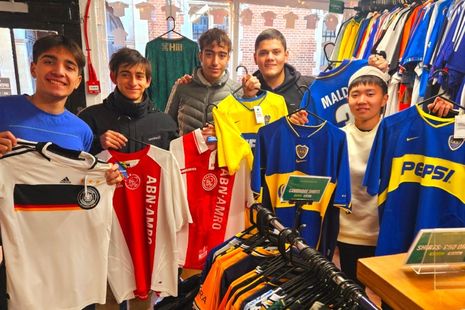Football’s threads: inside the football shirt phenomenon
Max Eshelby talks to Football Finery owner Chris Cooper about the growing obsession with football shirts and their place in popular culture

In recent years, the football shirt has evolved from a matchday essential into a global fashion statement. Once the preserve of fans and collectors, shirts now appear as often on the street, in fashion shoots, and across social media as they do on the terraces. Retro designs vanish from shelves quickly, vintage fairs are packed, and what was once a niche obsession has transformed into a cultural staple. To explore how football shirts have found a new meaning beyond the game, I visited Football Finery to talk with owner Chris Cooper about nostalgia, design and the memories stitched into every shirt.
Tucked among the independent shops of Magdalene Street, Football Finery draws the eye with a riot of colour. Vibrant rows of shirts hang neatly in place, bearing bold patterns, retro sponsors, and some of football’s most iconic names. For Cooper, the shirts are more than just collectables; they’re pieces of identity and history, and part of a culture built on shared memory and passion.
“I’ve been collecting since I was a kid,” he says. “I’ve always bought and sold as a collector - it started on eBay, then I made a website, and it just outgrew the house.” What began as a hobby became Football Finery, which attracts everyone from shirt enthusiasts to curious tourists. Retro fairs have helped to spread the word, and with the growing interest in football shirts in recent years, Chris eventually decided to “take the plunge” and turn his passion into a full-time business, which attracts everyone from lifelong collectors to curious tourists.
“The emotional connection that a football shirt provides is as strong as the aesthetic pull”
The surge in demand for football shirts is something that Chris has witnessed first-hand, and it became increasingly evident as we spoke. During our conversation, a steady stream of customers drifted in and out, pausing to flick through the rails. One customer was on the search for a Spurs shirt, while another enquired about whether Chris had any Sporting Lisbon strips available. “There’s been a move towards re-used, vintage clothing as streetwear,” he explained, gesturing to the racks around us.
Social media has also enabled the online kit community to grow, transforming what was once a quiet collector’s niche into a lively global network. This has particularly helped in engaging with younger audiences. “What was a geeky middle-aged thing is now across all ages,” Chris chuckled, pointing out the rail for junior sizes. Chris himself began collecting shirts as a child, with his first being Spurs’ 1985/87 home strip. The scene, with Chris juggling conversation and customers, each drawn by nostalgia or curiosity, neatly captures just how far football shirts have come.
But for many, the emotional connection that a football shirt provides is as strong as the aesthetic pull. “Every shirt has a memory - it takes you back to times with friends,” Chris said, adding that “you see people’s faces light up, regardless of team”. That emotional pull explains why shirts from the 1990s have proved to be especially popular. The decade’s appeal is easy to understand: Italian football on Channel 4 brought continental stars like Maldini and Baggio to the British living room, while tournaments like Italia ’90 and USA ’94 produced kits as iconic as the game itself.
“Football shirts have become a form of cultural expression as much as sporting allegiance”
Some shirts, however, are in another league altogether. Chris discussed how he recently got his hands on a Fiorentina away shirt from 1992, which was famously banned due to the inadvertent use of a swastika pattern. Such a shirt can easily fetch several hundred pounds. Arsenal’s infamous ‘Bruised Banana’ kit from 1991 was also a shirt that sold quickly, being instantly recognisable to most football fans. But for Chris, it is the Netherlands’ 1988 home shirt that represents “the grail”.
As the market has expanded, so too have the challenges that come with authenticity. “You get people you know and trust to help you,” Chris says, but he notes that he is always looking for new suppliers. Authenticating can also be a tedious process, and is one that is becoming more sophisticated over time. Chris discussed how artificial intelligence is beginning to expedite the process, with tools like KitLegit being used to check labels and product codes.
Despite the practical difficulties, Chris is optimistic about the future. “The World Cup always brings more interest,” he says, adding that the growing interest in sustainable fashion has offered a new lease of life, with pop-events appearing frequently across the country. “One in two blokes on the planet is a football fan,” Chris adds with a grin. “It’s great fashion. There’s huge potential.”
That blend of memory, identity and style has cemented the football shirt’s place in contemporary culture. Football shirts have become a form of cultural expression as much as sporting allegiance – something that speaks to both personal history and global connection. For Chris, the joy lies in those small moments when customers share their own stories, sparked by a certain design or badge. “You see people’s faces light up,” he says, “that’s what it’s all about.”
A simple shirt can bring back the sound of a crowd, the buzz of a matchday, or the image of a hero in motion. As Chris knows better than anyone, football shirts aren’t just about the game – they’re about everything that comes with it.
 Comment / Don’t get lost in the Bermuda Triangle of job hunting 24 November 2025
Comment / Don’t get lost in the Bermuda Triangle of job hunting 24 November 2025 News / Union elections kick off with contested presidential race22 November 2025
News / Union elections kick off with contested presidential race22 November 2025 News / Queens’ for Palestine stages second sit-in23 November 2025
News / Queens’ for Palestine stages second sit-in23 November 2025 News / Join Varsity’s editorial team this Lent 24 November 2025
News / Join Varsity’s editorial team this Lent 24 November 2025 News / English students fury at note sheet ban for exams21 November 2025
News / English students fury at note sheet ban for exams21 November 2025










